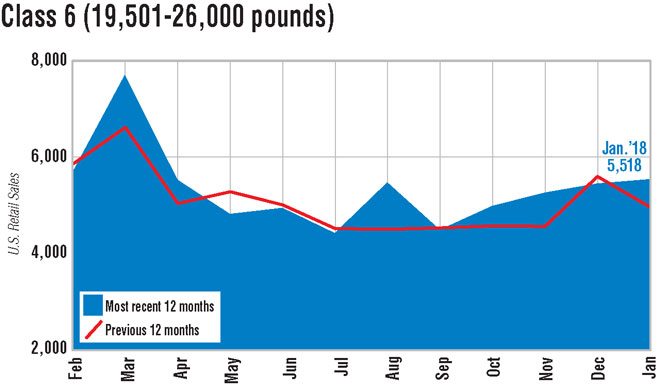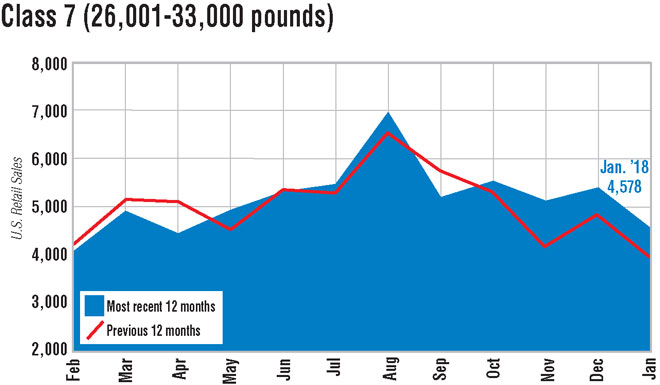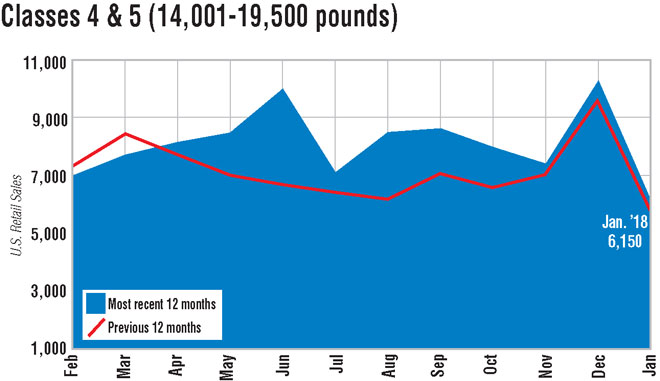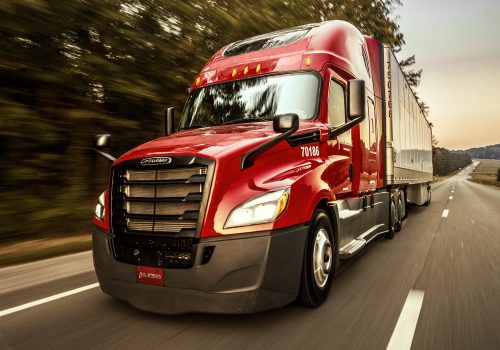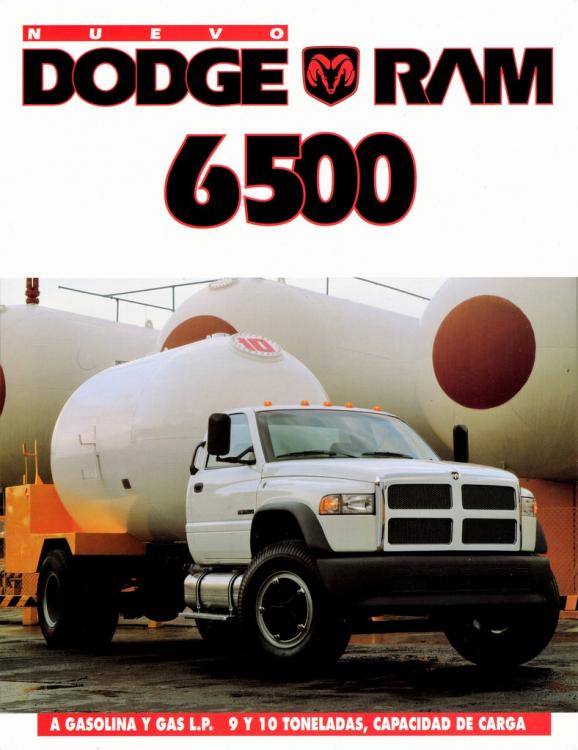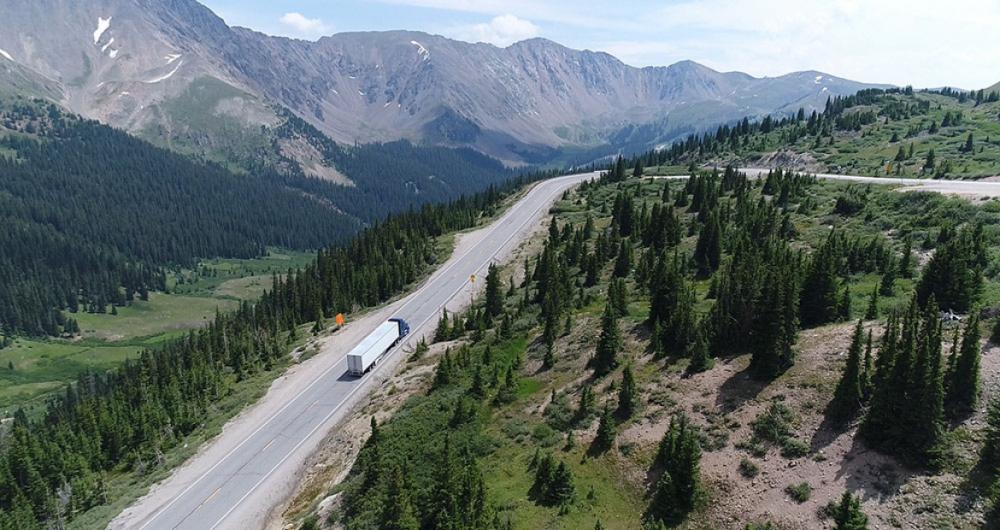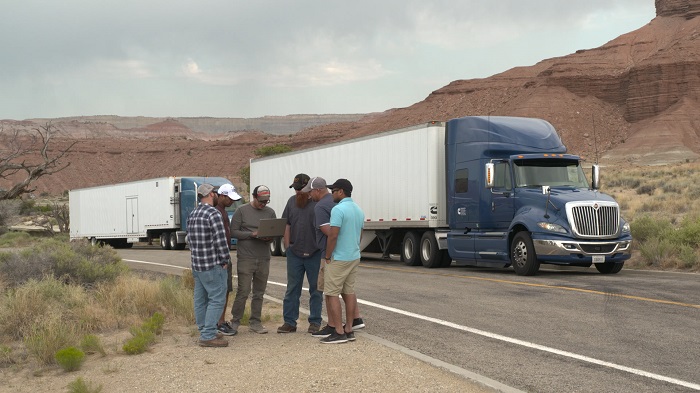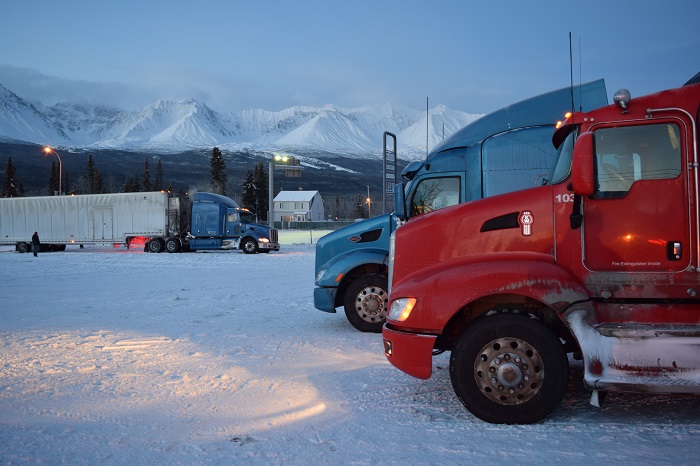
kscarbel2
Moderator-
Posts
17,892 -
Joined
-
Days Won
86
Content Type
Profiles
Forums
Gallery
Events
Blogs
BMT Wiki
Collections
Store
Everything posted by kscarbel2
-
Transport Topics / February 14, 2018 U.S. retail sales of medium-duty trucks in January surpassed 16,000 units, up 9.9% from a year earlier, WardsAuto.com reported. The report comes amid forecasts from engine maker Cummins Inc. that the 2018 market would improve compared with 2017. Wards said sales in Classes 4-7 vehicles were 16,246 compared with 14,782 a year earlier. “Medium-duty sales are continuing to build on the momentum in most, if not all, of 2017,” one analyst said. Sales climbed in all classes compared with the 2017 period. Class 7 improved the most, up 16.2%, to 4,578. Freightliner claimed a 51% market share, selling 2,333 trucks. Freightliner is a brand of Daimler Trucks North America. International, a unit of Navistar International Corp., sold 1,030, good for a 22% share. Peterbilt Motors Co. sold 614, up from 349 Class 7 trucks a year earlier. Peterbilt is a unit of Paccar Inc., whose total Class 7 sales reached 927, when including its other brand, Kenworth Truck Co. Ford Motor Co. with 173 sales, and Toyota Group’s Hino Trucks with 115, rounded out the Class 7 segment. Looking ahead to 2019, Hino plans to introduce a line of Class 7 trucks with its 9-liter engine built at its new assembly plant in West Virginia. Class 6 sales rose 10.7% to 5,518; Freightliner accounted for 2,279 of them. International and Ford battled for the second spot, with International selling 1,335 and Ford 1,199. Hino sold 457. Classes 4-5 sales climbed 5% to 6,150. Ford earned a 63% market share in the combined segment of lighter trucks, selling 3,872. Ford’s combined share included 3,556 Class 5 trucks. FCA’s Dodge Ram brand was next in Class 5 with 907. (FCA is a member of the Fiat Chrysler Automobiles N.V.) In the crowded Class 4 market, Isuzu Commercial Truck of America Inc. led with 501. Ford sold 316, Freightliner 222, General Motors Chevrolet LCF model sold 79, Hino sold 49 and DTNA’s Mitsubishi Fuso brand 19. In related news, engine maker Cummins Inc. forecast sales in the North American medium-duty markets it participates in, primarily Classes 6-7, will grow to 124,000 units, up 5% compared with 2017. The company projected its engine market share would be 72-75%. However, Cummins is expecting some share erosion from truck makers expanding their vertical integration of proprietary powertrains. Orders for Classes 5-7 in January were 31,700 units — the best month since July 2006 and the third-best month on record. .
-
Trump Supports 25-Cent Fuel Tax Increase to Fund Infrastructure Bloomberg / February 14, 2018 President Donald Trump told lawmakers he would support a 25-cent-per-gallon increase in federal gasoline and diesel taxes to help pay for upgrading American roads, bridges and other public works, Sen. Tom Carper of Delaware said Feb. 14. Carper, the top Democrat on the Senate Environment and Public Works Committee, said he was surprised that Trump raised the idea of the fuel tax increase several times during a meeting with a dozen Republican and Democratic lawmakers from key House and Senate committees. “While there are a number of issues on which President Trump and I disagree, today, we agreed that things worth having are worth paying for,” Carper said in a statement. “The president even offered to help provide the leadership necessary so that we could do something that has proven difficult in the past.” Oregon Rep. Peter DeFazio of Oregon, the top Democrat on the House Transportation and Infrastructure Committee, who also attended the meeting, said the president told lawmakers he also would be willing to increase the amount of federal spending beyond the $200 billion over 10 years that the administration is seeking for its infrastructure program. Trump previously has said he would consider raising the federal gasoline tax, which hasn’t been increased since 1993. Axios reported earlier that Trump endorsed a 25-cent increase during the meeting. White House officials declined to comment on Trump’s discussions in the closed-door meeting but said that all options were on the table to meet the main objectives of the president’s plan. "The president made a living building things, and he realizes that to build things takes money, takes investment,” DeFazio said. Pennsylvania Rep. Bill Shuster, the chairman of the House Transportation and Infrastructure Committee, has encouraged his Republican colleagues to consider raising the gas tax as a way to keep the Highway Trust Fund — which finances road, bridge and transit projects — solvent after 2021. He said there was discussion during the meeting about funding. “He understands that we’ve got to figure out the funding levels and where the money’s coming from, make sure it’s not smoke and mirrors,” Shuster said of the president. Groups including the U.S. Chamber of Commerce and American Trucking Associations support the idea of increasing the gas tax as the most efficient and easiest way to generate more money for projects, and the White House has been neutral. “We support the president’s big and bold vision for strengthening American infrastructure," said ATA President Chris Spear. "Because it is a user fee, the fuel tax is the most conservative, cost-effective and viable solution to making that vision a reality. Ninety-nine cents of every dollar goes directly to road and bridge maintenance, and it doesn’t add a penny to the deficit. There’s a reason why Ronald Reagan twice signed this idea into law.” But key Republican leaders have already rejected the idea and other entities, including the political network led by billionaire industrialists Charles and David Koch, are also opposed. Some critics say the tax is regressive because lower-income people pay a larger share of their income on the levy. Revenue from the federal per-gallon taxes of 18.4 cents on gasoline and 24.4 cents on diesel has declined as the average fuel economy of a passenger vehicle increased. Trump’s infrastructure plan seeks to revamp how projects are approved and funded by reducing permitting time to two years and allocating $200 billion over 10 years — mostly as incentives to spur states, localities and the private sector to spend at least $1.3 trillion. The administration released its 53-page plan Feb. 12 as a blueprint for Congress to draft legislation.
-
Florida High School Shooting - 17 confirmed dead
kscarbel2 replied to kscarbel2's topic in Odds and Ends
The murderer, 19-year-old Nikolas Cruz, has been arrested. Cruz set off the fire alarm so students would come pouring out of the classrooms into the hall. And then he began the carnage. Cruz was checked out at a hospital before being taken to a secure location in an unspecified public building. Democratic Rep. Ted Deutch of Florida says............lawmakers have offered their condolences. Matthew Walker, a 17-year-old student at the school, told WFOR-TV that all his classmates 'knew it was going to be him.' 'A lot of people were saying it was going to be him,' he said. 'A lot of kids threw jokes around saying that he was going to be the one to shoot up the school. It turns out that everyone predicted it. That's crazy.' 'He was going class to class just shooting at random kids,' he said. 'Everything he posts (on social media) is about weapons. It's sick.' . -
Florida High School Shooting - 17 confirmed dead
kscarbel2 replied to kscarbel2's topic in Odds and Ends
. -
Columbine, Sandy Hook, Virginia Tech, Parkland..........I’m really getting fed up with these school shootings. Clearly, though our government won’t discuss it, American society has serious issues today. Such actions never crossed our minds in our youth. https://www.theguardian.com/us-news/2018/feb/14/florida-shooting-school-latest-news-stoneman-douglas
-
Matt Cole, Commercial Carrier Journal (CCJ) / February 13, 2018 U.S. Xpress (No. 16 on the CCJ Top 250) announced this week it will offer $50,000 bonuses — paid in $2,000 increments and in vacation time over a four-year period — to current and future team drivers. For every 60,000 miles a team runs, they will receive $2,000 — $1,000 to each driver — along with $500 in paid vacation per driver, according to Danna Bailey, U.S. Xpress vice president of corporate communications. Bailey says teams can earn up to $8,000 each year in bonuses and $4,000 in vacation time by running 60,000 miles four times over the course of a year. If the drivers choose not to take vacation time, they will be paid $500 per driver for each week of unused vacation at the end of each year. After the team has earned a total of $48,000 in bonuses, which would take four years of driving at least 240,000 miles per year, each driver will receive a final payout of $1,000. Additionally, drivers in this program will have first priority on new trucks, will have top priority at service centers to minimize downtime, and can earn up to 82 cents-per-mile. .
-
My friend, a used TS442 manual would be superb investment, in support of your project. https://www.ebay.com/itm/Mack-Highway-Vehicle-TS-442-Service-Manual-Chassis-Components-/351086937912
-
Bigland takes over as president & CEO of Ram Truck Brand
kscarbel2 replied to kscarbel's topic in Trucking News
Sergio couldn’t possibly ignore the Class 6 opportunity. -
Bigland takes over as president & CEO of Ram Truck Brand
kscarbel2 replied to kscarbel's topic in Trucking News
-
Tesla can produce 100,000 electric Class 8 trucks a year: CEO Trailer-Body Builders / February 12, 2018 Tesla will produce at least 100,000 of its new Class 8 electric Semis a year within four years, company founder and CEO Elon Musk predicted. Speaking on the company’s quarterly earnings conference call with analysts a day after his dramatic SpaceX rocket launch, Musk also said Tesla “might be able to exceed the specs that we unveiled last year,” though he did not expand on those comments. He did, however, stress that “100,000 units a year is a reasonable expectation. Maybe more, but that's the right – roughly the right number, I think.” In November, Tesla unveiled the electric Class 8 truck, and said prices will start at $150,000 for a model with a 300-mile range, and $180,000 for a 500-mile range. During the conference call, Philippe Jean Houchois of Jefferies International Ltd. inquired whether a surge of energy in slowing down or braking the truck would be too much for a battery to absorb, and whether Tesla was considering using a super capacitor. Musk responded that “lithium-ion chemistry is so good at this point that capacitors will not be needed.” Jeffrey B. Straubel, Tesla’s chief technical officer, chimed in that “the power to energy demand on the battery in the heavy truck is actually generally less than in our performance vehicles.” Musk also said a self-driving Tesla car will attempt a trip to New York from Los Angeles within the next six months. Previously, he said Tesla would complete that test trip in 2017. Musk reiterated his belief that Lidar is not required to autonomous driving. Lidar, the technology used by numerous firm involved in autonomous driving, is short for light detection and ranging. Instead, Tesla will rely on cameras, radar, and ultrasonic sensors. “Now perhaps I am wrong,” Musk said. “In which case, I'll look like a fool. But I am quite certain that I am not.”
-
Transport Topics / February 12, 2018 The Trump White House’s highly anticipated infrastructure funding plan released Feb. 12 calls for states to be given flexibility from federal tolling restrictions and to be able to reinvest toll revenues in infrastructure. The trucking industry, for the most part, has rejected efforts that would lead to new tolls on existing interstates. Lifting or relaxing the federal ban on tolling interstate highways falls under Congress’ jurisdiction. “Tolling restrictions foreclose what might otherwise serve as a major source of revenue for infrastructure investment,” according to the White House’s 55-page document titled, “Legislative Outline for Rebuilding Infrastructure in America.” “Providing states flexibility to toll existing interstates would generate additional revenues for states to invest in surface transportation infrastructure. Current requirements that states must reinvest toll revenues in infrastructure would continue to apply,” the plan continued. Tolling is among the strategies proposed for realizing $1.5 trillion in infrastructure investments over 10 years. The plan also calls for states to have flexibility to commercialize interstate rest areas, as well as eliminating constraints on public, private partnerships for transit projects. “To be clear, new tolling on existing interstates is a non-starter for our industry. Tolls are ineffective and wasteful, with as much as 33% of revenue being wasted on administrative and overhead costs,” said American Trucking Associations President Chris Spear. Overall, $200 billion in direct federal funds would be sought to achieve the plan’s desired top line. From that, $100 billion would be made available for an incentives program for states and local agencies, $50 billion would be allocated for rural projects through block grants, $20 billion would be dedicated for a “transformative projects program,” $20 billion would be used to enhance existing federal credit programs and broadening the use of private activity bonds, and $10 billion would back the creation of a Capital Financing Fund. “The United States has fallen further and further behind other countries,” President Donald Trump said in a statement accompanying the plan. “It is time to give Americans the working, modern infrastructure they deserve.” Streamlining the permitting process for infrastructure projects is another key piece of the proposal. A “one agency, one decision” environmental review structure would be established. Also, the Council on Environmental Quality (CEQ) would issue regulations meant to streamline the National Environmental Policy Act (NEPA) process. “Requiring CEQ to revise its regulations to streamline NEPA would reduce the time and costs associated with the NEPA process and would increase efficiency, predictability and transparency in environmental reviews,” according to the plan. The plan is meant as guidance for Congress. It is unclear when the Republican-led chambers will legislate on infrastructure. Trump is expected to meet with congressional leaders Feb. 14. The leaders of the Senate Commerce Committee agreed infrastructure funding merits quick attention. “Through this guidance and letting Congress have the opportunity to write bipartisan legislation, President Trump has offered us direction to meet infrastructure needs in our nation’s states, cities and rural communities,” said committee Chairman John Thune (R-S.D.). The panel oversees trucking policy. “Aligning federal infrastructure funding with local priorities and looking at other impediments to building would increase accountability and help us meet our most critical infrastructure needs faster.” “Modernizing our transportation and communication networks is something we all agree the U.S. desperately needs in order to create more jobs and maintain our leadership in the global economy,” added panel ranking Democrat Bill Nelson of Florida. Rep. Bill Shuster (R-Pa.), chairman of the Transportation panel in the House, stressed the need for having presidential leadership and bipartisan cooperation to finalize a long-term infrastructure funding measure. Reaction from key stakeholders, meanwhile, has been less than enthusiastic. NATSO, the national association representing America’s truckstops and travel plazas, expressed concern about certain ideas in the plan. “Interstate tolls cost the government significantly more to administer and enforce than the existing motor fuels tax. Why would anyone fail to support an increase in the fuel tax and, at the same time, work to create another type of tax (such as toll roads) that costs more to collect than the fuel tax?” said NATSO President and CEO Lisa Mullings. Transportation Secretary Elaine Chao defended the rationale behind tolling. “We are not forcing toll roads on anyone. But we should also not discriminate against those entities that would like to have the private sector enter and participate and be a partner in their rebuilding of their infrastructure, as well,” she told reporters shortly after the plan was unveiled. “So, again, we are not pushing for toll roads. We’re also not forbidding toll roads.” Asked if the administration had ruled out a fuel tax increase to boost infrastructure funding, Chao added, “Nothing is off the table.”
-
Ford, Mazda expand 'do not drive' warning to additional pickups Reuters / February 12, 2018 WASHINGTON -- Ford Motor Co said Monday it is expanding an urgent warning to another 33,000 owners of older pickups in North America not to drive them until they get repairs because of a potentially defective Takata Corp. airbag inflator. Ford in January had urged 2,900 owners of 2006 Ford Ranger pickups to stop driving immediately until they can get replacement parts after a second death was linked to inflators built on the same day. The expansion of the warning was prompted by additional testing, the company said in a statement, and now covers a broader timeframe of production. Mazda Motor Corp. said it was issuing a similar expansion for about 1,800 2006 Mazda B-series trucks that were built by Ford after it had issued a warning for 160 trucks in January. NHTSA said the vehicles pose “an immediate risk to safety” and asked owners to immediately schedule a free repair. Ford and Mazda have replacement airbag inflators available now and will tow vehicles to a dealership for repair, and provide loaner vehicles free of charge, the companies and agency said. About 90 percent of the vehicles subject to the "do not drive" warning are in the United States. Two U.S. senators in January questioned why Ford’s warning applied only to a small number of the 391,000 2004-06 Ranger trucks recalled for Takata airbags in 2016 in the United States. Ford said last month a July 2017 crash death in West Virginia in a 2006 Ford Ranger was caused by a defective Takata inflator after a similar 2015 death in South Carolina. At least 22 deaths worldwide are linked to the Takata inflators that can rupture and send deadly metal fragments into the driver’s body. The faulty inflators have led to the largest automotive recall in history. The other 20 deaths have occurred in Honda Motor Co. vehicles, most of which were in the United States. About a quarter of the 2,900 vehicles have been repaired since Ford issued the warning last month, the company said Monday. Takata in June said that it has recalled, or expected to recall, about 125 million vehicles worldwide by 2019, including more than 60 million in the United States. About 19 automakers worldwide are affected. Takata inflators can explode with excessive force, unleashing metal shrapnel inside cars and trucks and have injured more than 200 people. The defect led Takata to file for bankruptcy protection in June.
-
A8-R897RSX https://www.bigmacktrucks.com/topic/8229-big-aussie-mack/ https://www.bigmacktrucks.com/topic/33150-when-mack-ruled-the-roads-of-iran-part-2/?tab=comments#comment-211876 http://forums.dhsdiecast.com/default.aspx?g=posts&t=134678
-
Ram plan brings Detroit ripples Larry Vellequette, Automotive News / February 12, 2018 FCA US' plan to spend $1 billion to move production of its heavy-duty Ram pickup out of Mexico has big economic implications for Detroit. But it's unclear how far the project's ripples will spread — or when. Suppliers are typically the biggest generators of jobs in a major plant project, but FCA already has a large number of truck suppliers in the Detroit area, says Mike Robinet, managing director of IHS Markit's automotive global advisory practice. Last month, the automaker revealed that in 2020 it will move heavy-duty Ram production from Saltillo, Mexico to its Warren, Mich., assembly plant north of Detroit. In discussing the plan with reporters, FCA CEO Sergio Marchionne called moving the pickup to Mexico in 2008 "an error." The Warren plant already is scheduled for a major capital project, handing off production of the light-duty Ram to a nearby Detroit-area assembly plant with increased capacity, while Warren will be repurposed to build high-end, body-on-frame Jeep SUVs. Adding the heavy-duty Ram will require the automaker to hire 2,500 workers on top of the work force needed for the Jeep plan, FCA said last month. But unclear is how much additional spending or how many more Detroit-area jobs will be created by suppliers to the pickup. Many heavy-duty Ram suppliers are also likely to provide parts for the light-duty Ram 1500, which has been moved 10 miles north to FCA's Sterling Heights, Mich., assembly plant. Robinet believes bringing the heavy-duty Ram to Michigan will shore up some suppliers that might have had production decline in recent years. But other suppliers will need to make new investments and add workers, he said. The Ram supply chain has received few specifics. An FCA representative told suppliers in a three-minute conference call on Jan. 26 that they should continue planning to support the launch of the next-generation heavy-duty Ram in Saltillo in January 2019, with their current parts plants, according to one supplier on the call. The FCA representative said that early builds of the next-generation heavy-duty pickups would be produced in Mexico through April of this year, with preproduction models starting in October, also in Mexico. That schedule means that suppliers will have to be prepared to meet 2019 production requirements for the truck in Saltillo while preparing to launch parts for the truck 1,800 miles north in Michigan in 2020. "It's going to be a cost, no question about it," said Julie Fream, CEO of the Original Equipment Suppliers Association, which represents auto suppliers. "Who bears that cost will have to be negotiated between FCA and its suppliers." Marchionne said the Saltillo plant would be repurposed to build one-ton commercial pickups for export to FCA's Europe/Middle East/Africa, Latin America and Asia Pacific regions.
-
Ford rushes to build more SUVs Michael Martinez, Automotive News / February 12, 2018 LOUISVILLE, Ky. — Ford and Lincoln dealers can't get enough of their biggest, most expensive SUVs to keep up with customer demand, which is a pretty good problem to have. But it's a problem nonetheless, one that Ford Motor Co. is addressing with a $25 million investment to speed up the assembly line here. The automaker planned to announce the upgrade to its Kentucky Truck Plant on Monday, Feb. 12. The investment, on top of $900 million already spent on the plant to launch the 2018 Ford Expedition and Lincoln Navigator, will allow Ford to build 25 percent more of the SUVs this year than originally planned. "It's important for this plant to produce more vehicles," Joe Hinrichs, Ford's president of global markets, told reporters here. "In this segment, people will pay for a great product. The dealer feedback has been even stronger than we've hoped for." Retail sales of the vehicles skyrocketed in January, up 59 percent for the Expedition and 132 percent for the Navigator. (Ford attributed a 15 percent decline in total Expedition sales to the timing of fleet orders.) The highly profitable SUVs are turning on dealer lots almost as fast as they can be unloaded from delivery trucks. It had been a decade since the Navigator was fully redesigned, and 20 years since the Expedition got a thorough overhaul. "Both of the vehicles are doing really well for us," Ford sales analyst Erich Merkle said. "Because they're turning so fast, we're going to do everything we can to meet the demand that's out there." CEO Jim Hackett has banned Ford employees from ordering Navigators or Expeditions for personal use, a source with direct knowledge of the directive told Automotive News. Typically, employees who get vehicles through the company's manager lease program can have their pick of the lineup, excluding some high-performance models. Restrictions on mainstream vehicles are rare, if not unprecedented, the source said. The Expedition — starting at $52,890, including shipping — is averaging just 11 days on dealer lots. The average transaction price rose $7,800 in January thanks to a 29 percent mix of the most expensive Platinum trim, which starts at $76,595. That's double the mix of Platinum models sold of the outgoing SUV, Merkle said. Navigator sales are up triple digits in every region of the country, including a 135 percent gain in Ford's western sales region, which includes California, Merkle said. Average transaction prices surged in January, up $21,300 over the same month last year. That's because 84 percent of sales were of the high-end Reserve ($82,400 sticker) and Black Label ($96,650 sticker) trims. "We could have sold a lot more in January if we had them," Mark LaNeve, Ford's vice president for U.S. marketing, sales and service, said on a Feb. 1 conference call. Kevin Collins, president of Bill Collins Ford-Lincoln in Louisville, said Expeditions and Navigators are sitting at his store for only five or six days before they're sold. "Stock is low right now and they're selling very, very well," he said. "We hope the days supply will continue at that rate because they're expensive; a dealer can't afford to have them sitting around too long." Collins said customers have been impressed with both the exterior style changes and the interior technology. "They're fine, fine products that we're really proud of," he said.
-
Jaguar revives D-Type roadster as a 'once-in-a-lifetime' project
kscarbel2 replied to kscarbel2's topic in Odds and Ends
Lucas.......the people who invented darkness. -
Hyundai Group, LG, Samsung.......very serious and competent global players.
-
Communist Party-backed Geely wants major Daimler stake
kscarbel2 replied to kscarbel2's topic in Trucking News
Don't take this at face value. Geely is merely a means with which to gain more advanced technology. The actual interested parties are China's NDRC and SASAC. NDRC - National Development & Reform Commission SASAC - State-owned Assets Supervision & Administration Commission of the State Council -
Blair Claflin, Cummins Inc. / December 20, 2017 Cummins engineer Trent Berardi was in trouble. Usually frigid Fargo, North Dakota (U.S.A.), was too warm. With his team ready for two-and-a-half weeks of testing Cummins’ X12 engine under extreme winter conditions, Berardi had to quickly find cold temperatures close enough to his base in Columbus, Indiana (U.S.A.), to stay on time and budget. Then he got the good news: Idaho Falls, Idaho (U.S.A.), was having a cold snap. “Thankfully, we found the temperatures we were looking for relatively nearby,” Berardi recalled. Such is the life of a validation engineer, the last line of defense before a Cummins product reaches the customer. These engineers oversee final testing to make sure a new engine platform or another Cummins product works when installed in a truck or other equipment. The testing frequently includes a two-to-three week road trip to see what happens when the engine is stressed by extreme temperatures or elevation. Engineers say some things can only be discovered on the road. “You’re looking for gaps between systems,” said Berardi, a Senior Validation Engineer in the Cummins Engine Business. “It’s like playing chess on a three-dimensional board.” LONG DAYS, SHORT NIGHTS, EXTREME TEMPERATURES Validation testing takes place not only at Cummins facilities in the U.S., but in China, India, the U.K. and elsewhere. U.S.-based teams have traveled as far as Fairbanks, Alaska, and Death Valley, California, to find the ideal combination of temperature and grade. In the U.S., trips can include 8 to 10 vehicles, counting support vehicles, and as many as two-dozen engineers, some flying in to observe just part of the testing. Winter trips mean temperatures as low as 40 degrees below zero Fahrenheit (- 40° Celsius). Summer trips can include daytime highs up to 120°F (49° Celsius). Elevation testing usually takes place at 10,000 to 12,000 feet (3,048 to 3,658 meters) above sea level. A 17-hour day is pretty common and the most important hotel amenity is truck parking. Hotel parking lots are frequently used for emergency repairs. Despite the challenging conditions, validation engineers say they love the trips. “I think it’s the chance to really see how our products work,” said Jeffrey Friend, a Controls Performance Engineer based in Columbus who estimates he’s been on about 30 validation trips over 17 years with Cummins. “You’re out there with engineers who are experts in their field and there’s no phone calls, no meetings, you just focus on the product.” The testing usually involves traversing steep grades, or going from zero to 60 miles-per-hour (97 kilometers-per-hour) as rapidly as possible – commonly referred to as “drag racing” by validation engineers. The fun really begins, they say, when they “break something” – a catchall term that could involve just about anything limiting performance. Then the team has to figure out how to make improvements. “That’s when you get a chance to find something you can improve on before our product gets in the hands of the customer,” said Beth Wendel, a Validation Group Leader in the Engine Business. “That can be very exhilarating.” TALES FROM THE ROAD After a 6-month college internship on an oil tanker crossing pirate-infested waters off the coast of West Africa, Chitresh Sharma rarely gets car sick even going up and down mountain roads looking at data on his laptop. But the Senior Engineer in Product Validation at Cummins vividly remembers his time in a truck making run after run to test a Cummins engine in the desert outside Las Vegas, Nevada (U.S.A.). He asked the technician driving the truck they shared to turn off the air conditioning and roll up the windows to reduce drag as much as possible. Sharma will soon be taking a new position in Cummins’ supply chain organization, but he says “I know I’ll miss this job, and I think I’ll end up missing these trips most of all.” Friend recalls how one team he was with solved the lack of suitable restaurants in Death Valley by storing deli trays in a refrigerated truck they were testing, and during a break in the desert backing it up to another truck, creating a cool area to eat. “Problem solving is really central to all aspects of these trips,” he said. Perhaps no one has more stories about validation testing than Greg Sitzman, a Mechanical Engineering Associate based at the Cummins Technical Center in Columbus. He estimates he’s been on 50 validation trips over 10 years with the company. Sitzman has been to Alaska five times, Death Valley, International Falls, Minnesota, and many other locations. He’s driven the Alcan Highway dividing Canada and Alaska, and put chains on a test truck to keep it from sliding through the Rocky Mountains. Once he even made a repair near Yellowknife in Canada’s Northwest Territories parked on a frozen lake. That enabled him to easily slide under the truck. But he says what he likes best about the trips is the camaraderie. “To me, while I enjoy the challenges, what makes these trips special are the people,” Sitzman said. “They make it fun. They are just good people to be with.” .
-
So that has a 3-cylinder 20-horsepower Yanmar diesel?
-
Jaguar revives D-Type roadster as a 'once-in-a-lifetime' project
kscarbel2 replied to kscarbel2's topic in Odds and Ends
BC Mack, brand new D-Types in year 2018.........who could have ever thought.
BigMackTrucks.com
BigMackTrucks.com is a support forum for antique, classic and modern Mack Trucks! The forum is owned and maintained by Watt's Truck Center, Inc. an independent, full service Mack dealer. The forums are not affiliated with Mack Trucks, Inc.
Our Vendors and Advertisers
Thank you for your support!


